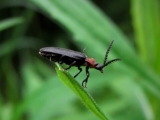
Cyphonocerinae
Encyclopedia
The Cyphonocerinae are a subfamily of fireflies (Lampyridae) with only a few handful of species
in (presumably) 2 genera
found in North America
and Eurasia
. Its taxonomic history is confusing; it has at various times been included in the now-abolished Amydetinae or the Lampyrinae
(which made these paraphyletic).
Alternatively Psilocladius was included herein, in which case it was united with and became a junior synonym of the Psilocladinae, but this appears to be incorrect and the latter group is nowadays usually included in the Lampyrinae. Stenocladius on the other hand, usually placed in the Ototetrinae
, might actually belong to the present subfamily, but more study of this peculiar genus is necessary.
Related to the Luciolinae
and Ototetrinae, the Cyphonocerinae appear to be one of the most primitive living lineages of fireflies. In fact, this group is so plesiomorphic that Cyphonocerus was not recognized as a firefly and placed in the Drilidae when it was first described. Cyphonocerus can display weak light signals, while Pollaclasis (and Stenocladius) have only the plesiomorphic pheromone
signals like their relatives.
The genera placed in the Cyphonocerinae are:
Species
In biology, a species is one of the basic units of biological classification and a taxonomic rank. A species is often defined as a group of organisms capable of interbreeding and producing fertile offspring. While in many cases this definition is adequate, more precise or differing measures are...
in (presumably) 2 genera
Genera
Genera is a commercial operating system and development environment for Lisp machines developed by Symbolics. It is essentially a fork of an earlier operating system originating on the MIT AI Lab's Lisp machines which Symbolics had used in common with LMI and Texas Instruments...
found in North America
North America
North America is a continent wholly within the Northern Hemisphere and almost wholly within the Western Hemisphere. It is also considered a northern subcontinent of the Americas...
and Eurasia
Eurasia
Eurasia is a continent or supercontinent comprising the traditional continents of Europe and Asia ; covering about 52,990,000 km2 or about 10.6% of the Earth's surface located primarily in the eastern and northern hemispheres...
. Its taxonomic history is confusing; it has at various times been included in the now-abolished Amydetinae or the Lampyrinae
Lampyrinae
The Lampyrinae are a large subfamily of fireflies . The exact delimitation, and the internal systematics, are a matter of debate; for long this group was used as a "wastebin taxon" to hold any fireflies with insufficiently resolved relationships...
(which made these paraphyletic).
Alternatively Psilocladius was included herein, in which case it was united with and became a junior synonym of the Psilocladinae, but this appears to be incorrect and the latter group is nowadays usually included in the Lampyrinae. Stenocladius on the other hand, usually placed in the Ototetrinae
Ototetrinae
The Ototetrinae are a small and somewhat disputed subfamily in the firefly family . They are close to the Luciolinae in some respects, but do not glow or flash like the more advanced fireflies. Rather, they attract their partners with pheromones like many relatives of the firefly family...
, might actually belong to the present subfamily, but more study of this peculiar genus is necessary.
Related to the Luciolinae
Luciolinae
The Luciolinae are among the largest subfamilies of fireflies . They seem to be all "flashing" fireflies...
and Ototetrinae, the Cyphonocerinae appear to be one of the most primitive living lineages of fireflies. In fact, this group is so plesiomorphic that Cyphonocerus was not recognized as a firefly and placed in the Drilidae when it was first described. Cyphonocerus can display weak light signals, while Pollaclasis (and Stenocladius) have only the plesiomorphic pheromone
Pheromone
A pheromone is a secreted or excreted chemical factor that triggers a social response in members of the same species. Pheromones are chemicals capable of acting outside the body of the secreting individual to impact the behavior of the receiving individual...
signals like their relatives.
The genera placed in the Cyphonocerinae are:
- Cyphonocerus
- Pollaclasis Newman, 1838

